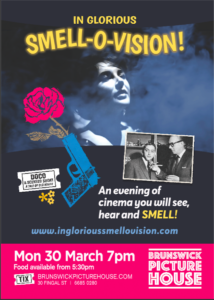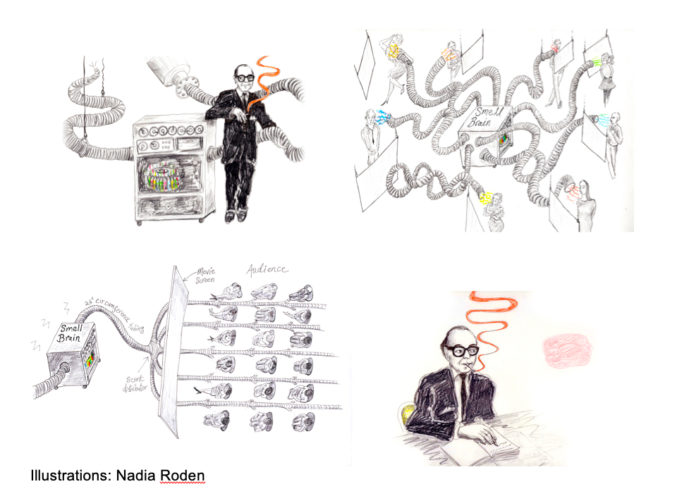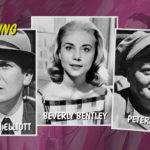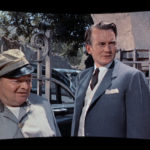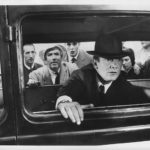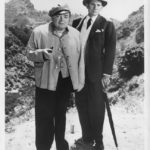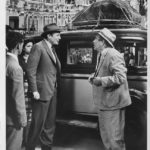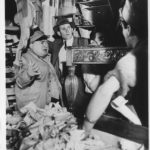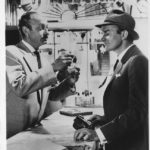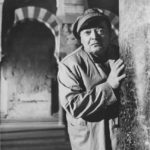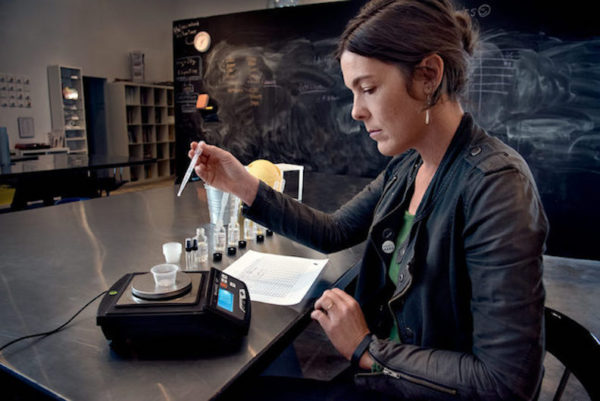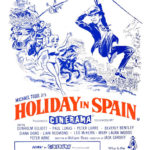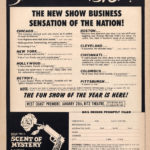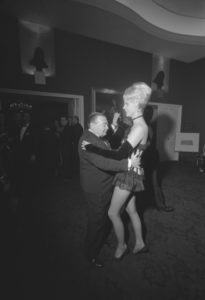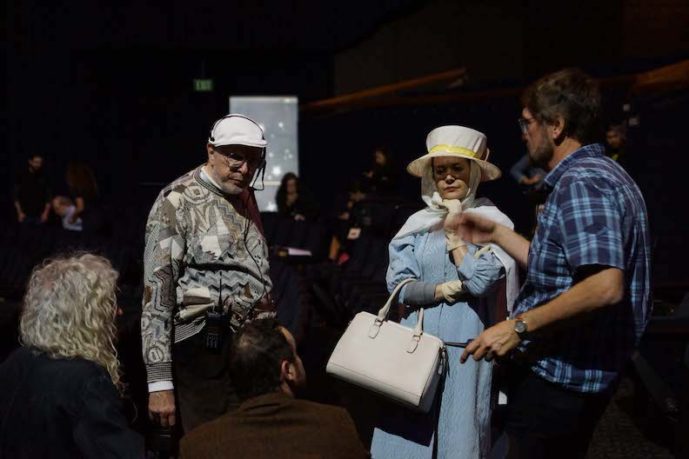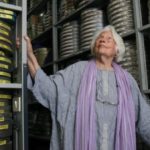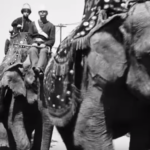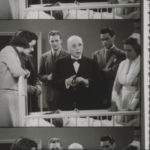Any Day is a Good Day for Smelling Movies
Reviving a concept that has had something of a stink about it
By Peter Monaghan
Late March was to have been Tammy Burnstock’s big moment in smelling movies.
Yes, smelling them.
For months, the Australian filmmaker and TV producer had been preparing for the premiere of her documentary film In Glorious Smell-O-Vision!: The True Story of the Godfather of Scented Cinema. It was to have been screened along with a great deal of olfactory frolicking. At the premiere, she and audience members were to have dispersed odors in the Brunswick Picture House in Byron Bay, on the east coast of Australia — odors linked to the unlikely tale her film relates.
In Glorious Smell-O-Vision! presents the curious history of Hans Laube’s ill-fated attempt, 60 years ago, to inject smells into cinemas that would augment films’ visuals and plot lines.
 Laube’s “Smell-O-Vision!” system has not been the only such attempt at merging cinema and scent, but it has been the biggest, and the most spectacular flop.
Laube’s “Smell-O-Vision!” system has not been the only such attempt at merging cinema and scent, but it has been the biggest, and the most spectacular flop.
Inglorious!
Or was it?
Burnstock (right) asks that question in her documentary film, which she created with Chicago-based Emmy-winning and Grammy-nominated director John Anderson. The Byron Bay premiere was to have been “an evening of scented cinema fun,” a “participatory movie experience exploring the secret history and promising future of scented cinema.”
Alas, its premiere was called off, or at least postponed, another victim of the Covid-19 disruptions.
It’s a sour coincidence that loss of smell appears to be one of the signs of infection.
A stinker of an idea
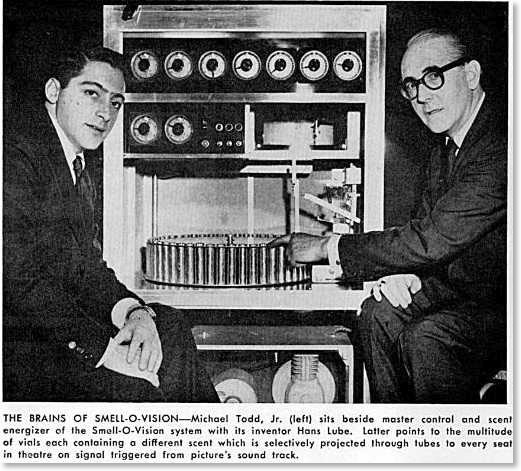
Hans Laube (right) explains his Smell-O-Vision system’s “brain” with Michael Todd Jr in some of the press coverage their efforts attracted.
The history of using scent alongside film is quite convoluted, but Hans Laube’s role is fairly well established. More on that later.
Most important is to note that Laube’s system was used for the Chicago Cinestage Theater run of Scent of Mystery, a 1960 mystery-comedy-travelogue in which aromas reinforced details of the plot — the scent of rose petals and tobacco smoke identified key characters. Oranges, the sea, and apricots came into play. So did baked bread, shoe polish, port wine, lavender, peppermint, and coffee as the action unfolded across a Spanish landscape of fiestas, a running of the bulls, dances, and street scenes in cities and towns.
Laube’s system, which was also used in a 1960 New York city run of Scent of Mystery, was ambitious, to say the least. Too ambitious to work particularly well, it would seem. Scents were dispersed from a central unit – a “smell brain.” It had perfume containers that were activated at appropriate points in the film’s projection. Those were determined by the containers’ placement on a belt linked to the film projector. Once the containers were activated, scent within them was fan-forced through pipes to vents at filmgoers’ seats.
What could go wrong?
The implementation could. It went badly. A hissing sound accompanied the release of scents, and the odors didn’t reach all audience members quickly or strongly enough, an inherent limitation of the system of dispersal.
By the time Laube improved those shortcomings, the film – and Smell-O-Vision! with it — had been panned by many of the critics and enough of the public.
Scent of Mystery, directed by Jack Cardiff, was written and filmed with scent as a vital part of the narrative. Smell-O-Vision! was not its only possible appeal. Its cast included one icon, Elizabeth Taylor (briefly, in a non-speaking role), one rising star, Denholm Elliott (Peter Sellers had been considered, but judged not funny), and one fading (but expanding) star, Peter Lorre (who almost died during the shooting), as an oddball taxi driver.
{Click on an image to expand}
The stars of the show. Much was made of the short appearance by Elizabeth Taylor (second from right) and of the photogenicity of Diane Dors in the role of “Miss Jordan.”
The producer of the film was Mike Todd, Jr., son of Mike Todd, who had recently produced the multi Academy Award winning widescreen Around the World in Eighty Days. In Scent of Mystery, a British mystery writer tries to protect an American heiress from murderers. Doesn’t sound too funny, but the setting and style made it into a proper Cinerama experience, and Smell-O-Vision! was to have made it something more.
Yet, as Burnstock related over coffee by a Sydney beach, the film reviews were brutal: “The critics hated it. And for a long time the story went that the whole thing was a disaster.”
At least comedian Henny Youngman had a sense of humor about it, saying: “I didn’t understand the picture. I had a cold.”
As Burnstock and Anderson relate in In Glorious Smell-O-Vision!, Laube’s process and even his concept seemed doomed to become a mere footnote in cinema history.
{Click on an image to expand}
Production stills from Scent of Mystery
But not everyone agreed. Some audience members loved the smells and the whole experience. That reinforces Burnstock’s belief that Hans Laube was, like many visionaries, just too far ahead of his time. She is convinced that Smell-O-Vision’s fate as a big-ticket addition to cinemas may not have doomed it, completely.
Laube’s process was unwieldy, and costly. Installation in some theaters could run to a million dollars – equivalent to almost $9-million, today. The concept was an uphill struggle from the start because — to state the obvious — film was historically a visual medium, not an olfactory one.
But, in Burnstock’s conception, scented cinema can rely on another core feature of films: people love to go to them. They love to be amused and entertained in them. Even, involved.
So she has made it her mission to give Hans Laube’s maligned process another chance. Kind of.
That a pared-down version of Smell-O-Vision! can work, she has no doubt. She has made it happen.
At three memorable screenings of a restoration of Scent of Mystery, she has produced low-tech, audience-assisted injections of scents.
The screenings were of Cinerama expert Dave Strohmaier’s restoration and remastering of the film. The first was the world première, in October 2015 at the Widescreen Weekend Festival of the National Science and Media Museum in Bradford, England, under the later title of the film, Holiday in Spain.
The second, that same month, was at the Danish Film Institute’s Cinematheque in Copenhagen.
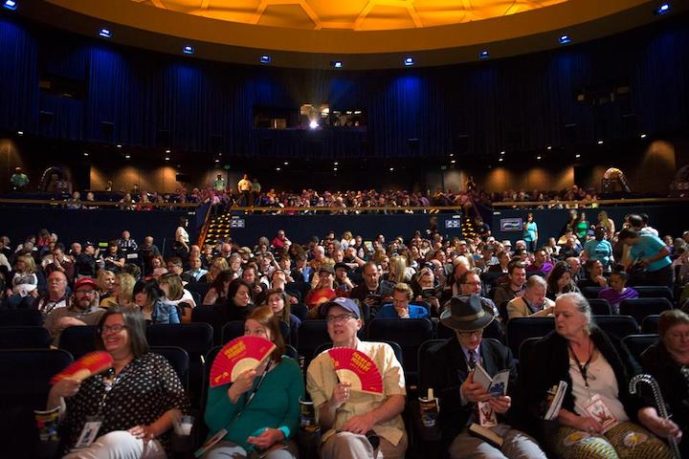
Tammy Burnstock produced a scent-assisted presentation of the restored Scent of Mystery at the TCM Classic Film Fest at the Cinerama Dome in Hollywood in 2016. With live actors setting the scene, large fans projected some atmospheric scents while audience members disseminated many others with small atomizers and folding fans. Photo: Mike Cahill.
The third was at the TCM Classic Film Fest at the Cinerama Dome in Hollywood in May 2016. With live actors adding to the scene-setting, large fans projected some atmospheric scents within the theater, while audience members disseminated many others, themselves, with small atomizers and folding fans.
Leonard Maltin was there, and afterwards wrote: “Having seen the movie on Blu-ray last year (and been unimpressed) my wife and I were skeptical that this presentation would be worthwhile. But with audience members opening spray vials on cue and using fans to spread the aromas we had to admit we were wrong.
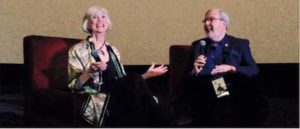 “The movie played much better on the curved Cinerama screen and the scents—from roses to red wine—wafted through the theater just as they were supposed to.”
“The movie played much better on the curved Cinerama screen and the scents—from roses to red wine—wafted through the theater just as they were supposed to.”
Some 700 people were in attendance, including Beverly Bentley from the original cast, as special guest (left, speaking with Leonard Maltin). “It was pretty bloody amazing,” exclaims Burnstock.
The scent mavericks
On those events, Burnstock collaborated with not only Dave Strohmaier, but also an international cadre of “scent mavericks,” as she calls them.
Those include, prominently, Saskia Wilson-Brown, founder of the Institute for Art and Olfaction, a Los Angeles nonprofit organization devoted to access, education, and experimentation with scent. At the Institute, Wilson-Brown has held such events as “scent weeks” that bring together innovators from around “the scent world.”
The Institute has also staged such projects as a 2013 scented screening of Tom Twyker’s film Perfume: The Story of a Murderer, based on a 1985 bestselling novel by Patrick Süskind about a smell-obsessed murderer. It was presented with scents composed by New York perfume-and-art duo Les Christophs (Christophe Laudamiel and Christoph Hornetz).
For screenings of the Burnstock/Anderson documentary, Wilson-Brown has provided, for example, a powerful scent she created, reimagining the one that accompanied Scent of Mystery’s running-with-the-bulls scene at the film’s 1960 premiere.
Wilson-Brown also provided Burnstock with a new smell: New York City in the 1950s. Scent of Mystery did not originally run with that one; rather, with the documentary film it will evoke Laube’s life there. “Bright but dirty,” is how she describes it to Burnstock.
It was scents like those that Burnstock was to have used at her documentary film’s première, and will, when it can actually happen.
Another will be by Cat Jones, an Australian artist who creates bespoke scents for use in immersive performance experiences. She has provided Burnstock with an odor of coffee and cognac for a “scent joke” involving Peter Lorre and some “coffee, very strong.”
For her approach to how to scent film, Burnstock cites the counsel of Luca Turin, one of the most prominent of the “scent mavericks”: “You need to keep the plumbing simple.” Make the scents the focus.
At Smell-O-Vision’s first outing, “there were far too many smells,” she says. She believes that a light touch in the use of smells is comparable to soundtracks that evoke emotions and memories almost without being noticed. “Music brings back memories, but smell is so primeval — you’re transported back in time and place in an even more immediate way.”
Of course, she adds, that kind of evocation can be a very personal matter. Most important is “to open people’s minds and noses to the world we live in,” as she puts it.
That applies outside of cinema, in everyday life, she professes. “I know my own sense of smell has gotten a lot better since I started doing this. Pretty much everything in our world is scented, and choices are often made for us in ways that are not healthy and not our choice.”
A Whiffy Tale
When it does finally get its première, Burnstock and Anderson’s In Glorious Smell-O-Vision! will begin with a cartoon short that accompanied the first run of Scent of Mystery: A Tale of Old Whiff (1960), by John Hubley, until 2016 thought lost forever.
I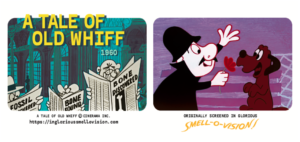 t’s about a bloodhound (played by Bert Lahr of Wizard of Oz fame) that must find a museum’s lost dinosaur bone although it has lost its sense of smell. (The cartoon is now available commercially as a DVD extra on the 2019 Flicker Alley DVD/Blu-ray release of Cinerama’s 1964 feature, The Golden Head.)
t’s about a bloodhound (played by Bert Lahr of Wizard of Oz fame) that must find a museum’s lost dinosaur bone although it has lost its sense of smell. (The cartoon is now available commercially as a DVD extra on the 2019 Flicker Alley DVD/Blu-ray release of Cinerama’s 1964 feature, The Golden Head.)
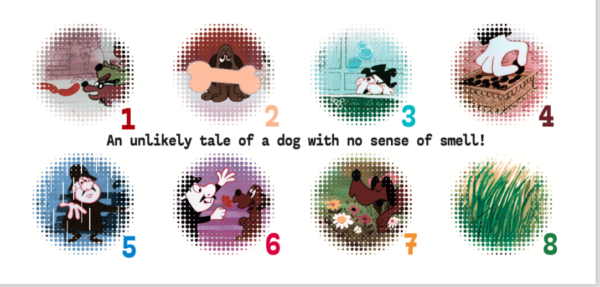 Then, Burnstock and Anderson’s film.
Then, Burnstock and Anderson’s film.
It was quite a few years in the making, she says. “As a labor of love, I started thinking about making it in 2015 when I started doing some revival events around Scent of Mystery.”
But its origins go back a good deal further. Burnstock had a career in children’s television production before her current activities — for over 30 years, internationally, including 12 at the Australian Broadcasting Corporation’s children’s television department. Anyone who has had kids in Australia and plenty of other countries during the last 30 years or more will recognize the programs she’s worked on, particularly Play School and Bananas in Pyjamas (including as its producer in 1994).
She worked on some Disney productions, too, and something called Talking Tom. “A lot of weird things,” she says.
And throughout those years, she thought about scented film. That’s because, even while studying writing and directing at the Australian Film and Television School, she wrote a final research paper on Laube’s scented-cinema efforts.
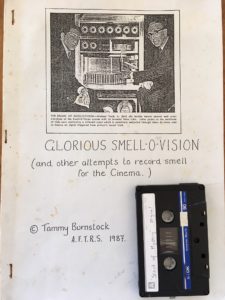 Hardly an obvious choice of topic, but “I always had a good sense of smell, and I was interested in scents,” she explains. Intent on finding more than was in the historical record, she wrote to Jack Cardiff, the prominent cinematographer and director of Scent of Mystery. (He directed Sons and Lovers in 1960, and had been the cinematographer for Black Narcissus, 1947, The African Queen, 1951, and War and Peace, 1956.) In response to her questions, he recorded spoken responses on a cassette tape. He was not at first encouraging: “Hello Miss Burnstock: By some ironic fate you have chosen a subject, the film I directed: Scent of Mystery, which is the one film I want to erase from my memory. The reason for this is that, through no fault of my own, the film was a complete disaster.”
Hardly an obvious choice of topic, but “I always had a good sense of smell, and I was interested in scents,” she explains. Intent on finding more than was in the historical record, she wrote to Jack Cardiff, the prominent cinematographer and director of Scent of Mystery. (He directed Sons and Lovers in 1960, and had been the cinematographer for Black Narcissus, 1947, The African Queen, 1951, and War and Peace, 1956.) In response to her questions, he recorded spoken responses on a cassette tape. He was not at first encouraging: “Hello Miss Burnstock: By some ironic fate you have chosen a subject, the film I directed: Scent of Mystery, which is the one film I want to erase from my memory. The reason for this is that, through no fault of my own, the film was a complete disaster.”
Turns out, however, that after that disavowal he raved about the film’s merits. It was Laube’s scents that he had deplored.
Burnstock says: “I hadn’t seen Scent of Mystery, at that point. It was a lost film.
“But Jack said it was brilliant.”
Laube, according to Cardiff, was little more than a fraud, one who had provided completely inadequate scents for the first run. At that point, Burnstock hadn’t had an opportunity to view the film, but she says: “Ever since then my passion for all things scented and my curiosity about this original stinker persisted.”
She eventually discovered that Jack Cardiff’s take on the original screenings was more negative than those of others who were there. Some remembered the scents as being true to the vision and the delivery system relatively effective.
{Click on an image to expand}
Burnstock’s research for her documentary film uncovered some of the history of the concept. Mike Todd (senior) had met Hans Laube many years before he embarked on the Scent of Mystery project — way back at the 1939 World’s Fair, where Todd had staged a series of musical films. Laube told Todd about his idea, which at that time was much simpler, with manually released scents.
Some 15 years later, Todd thought of asking Laube to add scents to Around the World in Eighty Days. That didn’t happen, but Todd Jr. did later sign Laube to a movie deal.
That finally bore fruit in 1960 with Scent of Mystery. Laube had obtained a US patent for his improved, automated system. It was Todd who renamed it Smell-O-Vision!
As preparations were being made for its roll-out, proceedings were complicated at the last minute when a competing scented-cinema system emerged. Hastily orchestrated, “AromaRama” was used in New York late in 1959 with Leonardo Bonzi’s documentary film about China, Behind the Great Wall. (Rotten Tomatoes describes AromaRama now as “a fleeting experiment in cinematic insanity.”)
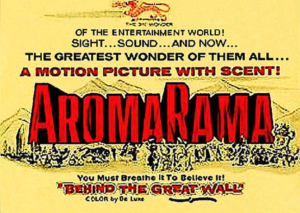 The AromaRama system dispersed scents via the theater’s air-conditioning system. Releases were triggered by the projector and scents were then cleared from the air — in theory — by a device, the “Statronic,” with electrically charged surfaces that blotted up scent-bearing particles.
The AromaRama system dispersed scents via the theater’s air-conditioning system. Releases were triggered by the projector and scents were then cleared from the air — in theory — by a device, the “Statronic,” with electrically charged surfaces that blotted up scent-bearing particles.
Walter Reade, Jr., the son of a cinema-chain founder, developed that system but had no more success with it than Todd with his Smell-O-Vision! It seemed rather cynically cobbled together. Reade bought the rights to Behind the Great Wall and tacked the scents on. The smells weren’t realistic, just embellishments — and reportedly distracted from rather than enhanced the visuals.
The competition to be the first scented film was dubbed the “Battle of the Smellies.”
The concept of injecting scent has had a longer spotty history. Around 1908, S. L. (“Roxy”) Rothafel, who later founded Radio City Music Hall, spread rose perfume with a fan while showing film of the Tournament of Roses at a theater in Forest City, Pennsylvania. Processes patented in 1930 and 1939 for releasing scents automatically during movies apparently were never deployed.
Then, with his 1951 patented system, Emery Stern hoped to distribute scents via theater ventilators, and then snuff them out with a neutralizing agent. Nothing much came of that, either — other than Reade using its principles.
In 1981, partly in homage to the “osmologist” Hans Laube and his innovation, John Waters distributed scratch-and-sniff cards with his feature film, Polyester. In Waters’ comical Odorama system, audience members scratched numbered scent patches when signaled by the film.
Apparently MTV showed Scent of Mystery sometime in the 1980s with a scratch-and-sniff card promotion, too.
A long-wafting idea
For Burnstock, only Laube’s Smell-O-Vision merits its own documentary film. She says that during the years after she wrote her film-school essay about it, she often recalled Cardiff’s initial recollections of its use with Scent of Mystery. That cassette tape kept spinning in her memory. It was clearly just a matter of time until she would revisit the subject.
Now she has told the tale with Anderson in their documentary film. To make it, she called on friends from her days in television production. To stretch a very limited budget. Michelle French, a motion-capture specialist, Caroline Saul, an archivist, and a musician, Peter Dasent, all helped. So did directors Varcha Sidwell and Brendan Young.
A big break came when John Anderson came on board. He makes music videos and documentaries about music, and was nominated for a Grammy Award in 2006 for directing the DVD about a never-released Beach Boys album, Brian Wilson Presents Smile.
He was able to interview Carmen Laube, the daughter of Hans Laube, about whom very little historical trace remained. “A lot of the backbone of our film is that interview,” Burnstock says.
Anderson was also able to interview Susan Todd, the daughter of Mike Todd Jr, for her take on the struggles that scented film had in its early days – it’s a story of ambitious men and their failure. “Our film is a combination of history told through daughters, and a future told by cutting-edge scent people,” Burnstock says.
As Anderson became more involved, he caught the scented-film bug, too. Now, he is organizing themed events in the US.
It’s clearly an infectious concept. Others who learned of the project and helped included photographer Art Shay. Anderson was able to interview him before he passed away in 2018 at the age of 96. Shay provided his photographs from the premiere of Scent of Mystery including shots of the Smell-O-Vision machinery — “how it all worked, and the splendor of it,” says Burnstock. “Art also gave us lots of anecdotes.”
She and Anderson managed to put a lot of archival footage into the film, despite a minimal budget — all, she quips, thanks to “the generosity of archivist strangers.”
When it came time to show a preview of the film for crew, late last year, the event was hosted by a New York Lower East Side small-theater operator, Michelangelo.
The real première
All Burnstock needs now is an opportunity for a full-scale public première. She’s ready for it. As the original late-March event approached, she set about assembling scents from all those “slightly mad scientists” in the new scent movement.
In her olfactory laboratory – her Sydney apartment — she organized her collection of vials, cards to load scents onto, and the scents themselves, including rose essence (Bulgarian, as that’s the best), perfumes featured in the original roll-out of Scent of Mystery, and much else. She has planned on having eight different scents that audience members will activate by simple means.
She has containers, dipsticks, and various mediums for disseminating her scents.
She also has scratch-and-sniff cards at the ready for the presentation of A Tale of Old Whiff.
It’ll clearly be quite an event, when it does happen. (Hopefully, in December, after current renovations of the Brunswick Picture House in Byron Bay are complete.)
It seems assured of a great deal of interest from film history buffs, particularly widescreen enthusiasts. There’s not only the historical interest, but the fun to be had. Burnstock and her Scented Storytelling team favor a lighthearted, audience-oriented approach that takes Burnstock back to one of her prime motivations for trying to revive scented cinema, at all: that she worries that children, in particular, need arts experiences that are more engaging and expansive than the usual current, passive, consumer-oriented options.
Scented-cinema events seem better for kids, but for adults, too.
She says: Come to the première and witness what happens when a film audience smells what they are seeing. Because the reception of smells is a very personal matter, it’s hard to deliver scent with great certainty about how it will be received. It won’t be perceived in the same way by everyone. But that’s where making Smell-O-Vision cinema events can be great fun, as communal experiences, she says. “People can look at each other and say, ‘Did you get that?’”
She goes so far as to suggest that such a form of cinema experience, rather than just a recipe for the success of scented cinema, could become an ingredient in the future viability of cinema, over all. “Participatory, communal events are what I think is necessary to keep cinema alive,” she says. “The energy in the room makes it a stronger experience for everyone.”
Previous Post: Funding for Recordings at Risk
Next Post: Film Archivists Preserve Accounts of What COVID-19 Has Wrought

